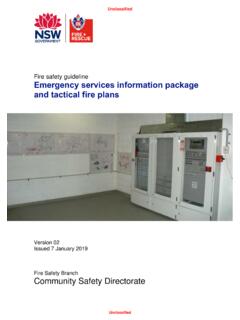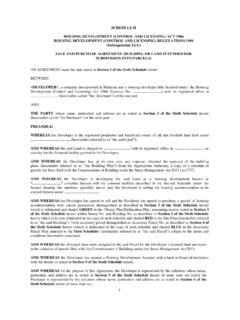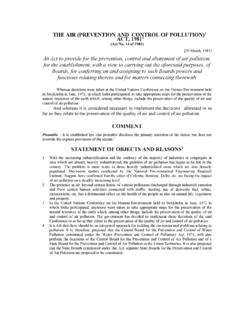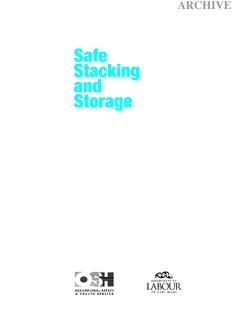Transcription of Fire safety guideline Technical information
1 Unclassified Fire safety guideline Technical information D16/62522 Version 01 Issued 27 February 2020 1 Copyright State Govt NSW Unclassified Uncontrolled if printed, copied or emailed, Always check the Fire and Rescue NSW website for the most recent version Fire hydrant concessions for existing buildings 1 Purpose This Technical information sheet provides advice to consent authorities on concessions acceptable to Fire and Rescue NSW (FRNSW) regarding the provision of fire hydrant coverage to an existing building or premises that is subject to a fire safety order. 2 Scope This Technical information sheet details: (a) the application of a concession acceptable to FRNSW, with conditions, on fire hydrant coverage for an existing building or premises (b) requirements for the location of feed fire hydrants and attack fire hydrants providing extended fire hydrant coverage (c) requirements for minimum performance and other ancillary items applicable to the fire hydrant system, and (d) recommendations to the consent authority determining an existing building or premises to which this fire hydrant coverage concession may apply.
2 3 Application This document applies to any existing building or premises which: (a) is subject to a Development Control Order (DCO) issued pursuant to Division of the Environmental Planning and Assessment Act 1979 by the relevant consent authority (b) is required to have a fire hydrant system installed to satisfy the requirements of Clause of the National Construction Code (NCC) and Australian Standard AS , and (c) does not contain fire isolated stairs. This document does not apply to any existing building or premises which: (a) proposes any building work by means of development consent ( complying development certificate or construction certificate), and (b) has, or is likely to have, manifest quantities of hazardous chemicals.
3 This document does not apply to any new building or premises. This document is to be used by the relevant consent authority when issuing the DCO. Where appropriate, the consent authority should reference this document for any existing premises that the corresponding DCO applies to. This document grants concession to a retrofitted fire hydrant system with reduced net benefit ( performance) compared to a fire hydrant system that complies with all NCC and AS requirements, which will typically incur much higher costs. Note: FRNSW are mindful of the greater financial burden to retrofit a fully compliant fire hydrant system to an existing building.
4 1 AS 2005 Fire hydrant installations, Part 1: System design, installation and commissioning Unclassified Fire and Rescue NSW Technical information sheet D16/62522 Fire hydrant concessions for existing buildings 2 Version 01 Issued 27 February 2020 Copyright State Govt NSW Unclassified Uncontrolled if printed, copied or emailed, Always check the Fire and Rescue NSW website for the most recent version When applying this document to any DCO, the resultant fire safety upgrade to the existing building or premises may not satisfy all performance requirements of the current NCC. Note: FRNSW acknowledge fire safety upgrades may not fully comply with the NCC.
5 When this document does not apply, including when the existing building does not meet the requirements for the concession to apply, the consent authority may consult with FRNSW by applying for comment on an occupied building. 4 Background Legislation applicable to building design have changed significantly over the last century. In 1912, the Height of Building Act 1912 and Ordinance 71 constituted the main building regulations in NSW. These regulations remained in place until repealed by Ordinance 70, with Ordinance 71 being repealed in 1974 and the Height of Building Act repealed in 1986. The Building Code of Australia (BCA) was first published in 1988.
6 However, the BCA was not adopted in NSW in NSW until 1993 via the Local Government Act 1993 Regulation (Local Government (Approvals) Regulation 1993). In 2011, the BCA was incorporated into a suite of building and plumbing codes, with the current NCC applying to buildings in NSW. Changes were made by regulators to keep pace with the building industry, to standardise building rules, or respond to significant events. As a result, buildings are designed to differing requirements depending on the provisions applicable at the time of construction. By example, a Class 2 building having a rise in storeys of not more than four did not require a fire hydrant system under Ordinance 70, but under the current NCC the same building would require an AS fire hydrant system be installed.
7 The concession provided in this document ensures applicable buildings and premises are still provided with fire hydrant coverage that enables firefighters to meet their statutory obligations and undertake firefighting intervention. FRNSW expects an existing building issued with a DCO to install a fire hydrant system, be fitted with a hydrant system complying with AS when this document does not apply. Note: While the current NCC references AS 2005, this document does make reference to specific provisions from AS 20172. 5 General requirements Minimum flow rate The minimum flow rate from each feed fire hydrant outlet providing coverage is to be determined in accordance with the requirements of section of AS 2017.
8 The number of feed fire hydrant outlets required to discharge simultaneously is to be determined in accordance with the requirements of section of AS 2017. Minimum residual pressure The minimum residual pressure at the outlet of a standpipe connected to a street fire hydrant, or the on-site feed fire hydrant, is to be not less than Table (A) of AS 2017 when flowing at the minimum required flow rate for that feed fire hydrant. Note: Greater head losses must be considered in the hydraulic calculations when two fire hydrants are required to flow simultaneously. The on-site feed fire hydrant is to have a back-flow prevention device installed according to the requirements of the relevant water supply authority.
9 The minimum residual pressure at the fire hydrant outlet is to include hydraulic losses associated with this device. 2 AS 2017 Fire hydrant installations, Part 1: System design, installation and commissioning Unclassified Technical information sheet Fire and Rescue NSW Fire hydrant concessions for existing buildings D16/62522 Version 01 Issued 27 February 2020 3 Copyright State Govt NSW Unclassified Uncontrolled if printed, copied or emailed, Always check the Fire and Rescue NSW website for the most recent version Method of measurement and limitations The method of measuring fire hydrant coverage is to be made in accordance with the requirements of section of AS 2017, including consideration of all limitations which impact on the laid-on ground distance.
10 Fire hydrant coverage within a building is the laid-on ground distance along paths of travel between the final exit ( open space) and the furthermost point inside the building. Hardstand areas Hardstand areas required for the fire appliance ( access to on-site feed fire hydrant) are to comply with the requirements of section of AS 2017. Note: Refer to FRNSW guideline Access for fire brigade vehicle and firefighters for further information . A public road may serve as the hardstand area. The hardstand area is to provide pedestrian access to the building entry point through which fire hydrant coverage is determined, as applicable to the portions of floor area being covered by that entry point.










